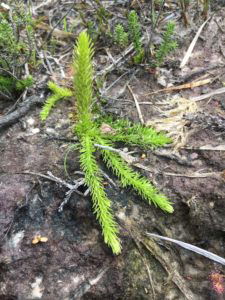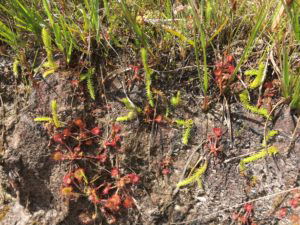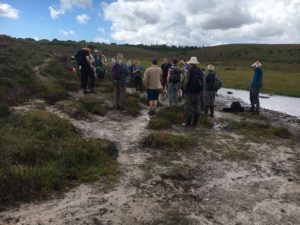Monitoring Marsh Clubmoss
10th August 2017
We’re training up a team of Marsh Clubmoss Species Monitors with Species Recovery Trust to protect this ancient plant

Never heard of Marsh Clubmoss? That’s not surprising. It’s only known from about 70 individual sites in the UK. It’s also easy to overlook as ‘just another moss’.

But, this small plant isn’t a moss at all. Lycopodiella inundata is in fact a type of fern, belonging to a strange relict family of plants which dominated the earth millions of years ago. It looks and feels like a fake plastic tree you’d put on the Christmas cake.
Clubmosses have a fascinating life cycle with above and below-ground horizontal stems and conifer-like vertical stems – known as strobili – which produce the spores. Then like a moss, the next stage (the gametophyte) happens in association with a symbiotic fungi. Once the gametophyte has grown it either produces sperm or eggs (and fertilisation occurs when the sperm swims towards the eggs in the wet habitats in which it lives). But, they can also reproduce asexually, when an extra horizontal stem grows and produces its own strobilus, which eventually breaks off to become its own plant.
 But enough of the fun facts and on with the story. Marsh Clubmoss is classified as endangered. Much of its favoured winter-wet peat sites, rutted trackways created by grazing animals and eroded channels of surface water draining over the bog, have gone, and the clubmoss along with it.
But enough of the fun facts and on with the story. Marsh Clubmoss is classified as endangered. Much of its favoured winter-wet peat sites, rutted trackways created by grazing animals and eroded channels of surface water draining over the bog, have gone, and the clubmoss along with it.
When the Species Recovery Trust surveyed the New Forest, Dorset Heaths, Thames Basin Heaths and Cumbrian stongholds previously, many of the sites looked to be in decline. It’s a real worry.
However, Marsh Clubmoss can have good and bad years so we need to visit them again and again. As with many things, regular monitoring is needed to allow us understand status and trends – this is the ethos of PondNet.

Thanks to the Heritage Lottery Fund and our PondNet volunteer network we are able to work with the Species Recovery Trust on a resurvey of all the known sites in the autumn and winter of 2017. We’re also keen to hear about new sites.
Dominic Price from the Species Recovery Trust told us:
Marsh Clubmoss is a truly remarkable plant; most closely related to the ferns, it has existed on the earth almost unchanged for 400 million years. It thrives best on bare peat where grazing animals or other forms of disturbance have opened up the vegetation, but unfortunately this habitat has drastically declined over the last century, with many heathlands fenced off and too small to graze becoming choked with dense vegetation.
It is however a satisfying species to work on; as with some tweaking, such as reintroducing grazing or even using heavy machinery to create ponds with shallow sloping margins, it can often be brought back. Our work on it has focussed on trying to keep all the sites regularly monitored and when conditions deteriorate at any one site act to reverse this. Recently we have been training a network of volunteers across the country to recognise the plants and the habitat that supports it. It may not still be around in another 400 million years, but we certainly hope in 40 years we can turnaround its recent decline in the UK.
 We’re very pleased to be able to work with the Species Recovery Trust to help monitor Marsh Clubmoss. We hope to run more training events in other parts of the country. If you are interested, drop us an email. We look forward to hearing from you.
We’re very pleased to be able to work with the Species Recovery Trust to help monitor Marsh Clubmoss. We hope to run more training events in other parts of the country. If you are interested, drop us an email. We look forward to hearing from you.
